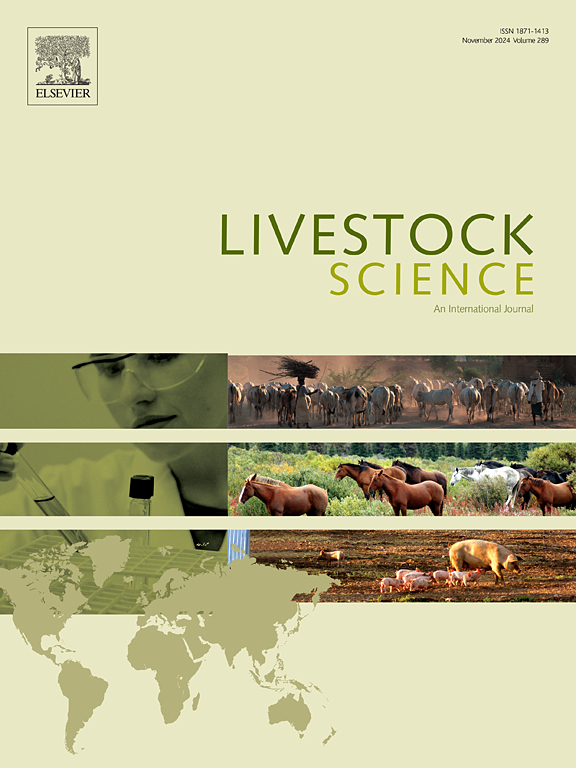Social interactions and movement patterns of rangeland-raised beef cows and their calves
IF 1.8
3区 农林科学
Q2 AGRICULTURE, DAIRY & ANIMAL SCIENCE
引用次数: 0
Abstract
Understanding the spatial and temporal relationships between beef calves and their dams is crucial for effective rangeland management. This study investigated these dynamics on semiarid rangeland using GPS collars fitted on cow-calf pairs. Data were collected on 46 crossbred cows and 34 calves grazing two adjacent 219 and 146 ha pastures. The primary objective was to determine the proximity of calves to their dams and other adult cows at different calf ages (1, 2 and 4 mos.). Over a 24 h period, calves spent on average 10.5 and 17.5 h within 5 or 10 m of an adult cow, respectively, and spent 2.6, 5.6 and 2.3 h within 5 m of their dams, other adult cows and a guard cow (cow other than the dam that spent the most time in the proximity of a calf), respectively. Calves spent more time within 5 or 10 m of an adult cow during night vs. daytime hours and spent detectably (P < 0.05) more time within 5 or 10 m of other adult cows vs. their dam (5.6 vs. 2.6 or 10.3 vs. 3.5 h). Calves spent a similar (P > 0.05) amount of time within 5 or 10 m of their dam vs. the guard cow (2.6 vs. 2.3 or 3.5 vs. 3.7 h) regardless of age during both day and nighttime hours. In general, calves spent more time within 5 and 10 m of an adult cow at 2 vs. 1 or 4 mos. of age. Greater mother-offspring clustering occurred at 2 vs. 1 or 4 mos. of age regardless of the spatial threshold considered. Regardless of calf age, calves and nursing cows traveled on average 4.5 and 6.7 km/day, respectively. Calves at 4 mo of age traveled farther than younger calves. Nursing cows traveled farther when calves were 4 mo. vs. 1 or 2 mos. of age and tended to travel farther when calves were 1 vs. 2 mos. old. Calves spent more time close to other nursing cows vs. their dam. These findings suggest that while dams play a crucial role in calf development, other nursing cows may also influence their foraging behaviors. Further research is needed to fully understand the dynamics of these relationships and their implications for rangeland management, such as optimizing grazing strategies and improving calf health and productivity.
牧场饲养的肉牛及其犊牛的社会互动和运动模式
了解牛犊与母牛之间的时空关系对于有效管理牧场至关重要。本研究利用安装在母牛和小牛身上的 GPS 颈圈,对半干旱牧场上的这些动态关系进行了调查。研究收集了 46 头杂交母牛和 34 头小牛的数据,它们分别在相邻的 219 公顷和 146 公顷牧场放牧。主要目的是确定不同犊牛年龄(1、2 和 4 月龄)的犊牛与母牛和其他成年母牛的距离。在 24 小时内,犊牛与成年母牛在 5 米或 10 米范围内的平均距离分别为 10.5 小时和 17.5 小时,与母牛、其他成年母牛和护卫母牛(与犊牛接近时间最长的母牛以外的母牛)在 5 米范围内的平均距离分别为 2.6 小时、5.6 小时和 2.3 小时。夜间与白天相比,犊牛在一头成年母牛身边5米或10米范围内停留的时间更长;与母牛相比,犊牛在其他成年母牛身边5米或10米范围内停留的时间明显更长(P < 0.05)(5.6小时与2.6小时或10.3小时与3.5小时)。无论昼夜,犊牛在其母牛与护卫母牛之间 5 或 10 米范围内停留的时间(2.6 对 2.3 或 3.5 对 3.7 小时)与护卫母牛停留的时间(P > 0.05)相近。一般来说,2月龄与1或4月龄的犊牛在成年母牛身边5米和10米范围内逗留的时间更长。无论考虑的空间阈值如何,2月龄与1或4月龄的犊牛的母子聚集程度更大。无论犊牛年龄大小,犊牛和哺乳母牛的平均旅行距离分别为 4.5 公里/天和 6.7 公里/天。4 月龄的犊牛比更小的犊牛走得更远。4月龄的犊牛比1或2月龄的犊牛走得更远,1月龄的犊牛比2月龄的犊牛走得更远。与母牛相比,犊牛与其他哺乳母牛相处的时间更长。这些发现表明,虽然母牛对犊牛的成长起着至关重要的作用,但其他哺乳母牛也可能影响它们的觅食行为。要充分了解这些关系的动态及其对牧场管理的影响,如优化放牧策略、改善犊牛健康和生产率等,还需要进一步的研究。
本文章由计算机程序翻译,如有差异,请以英文原文为准。
求助全文
约1分钟内获得全文
求助全文
来源期刊

Livestock Science
农林科学-奶制品与动物科学
CiteScore
4.30
自引率
5.60%
发文量
237
审稿时长
3 months
期刊介绍:
Livestock Science promotes the sound development of the livestock sector by publishing original, peer-reviewed research and review articles covering all aspects of this broad field. The journal welcomes submissions on the avant-garde areas of animal genetics, breeding, growth, reproduction, nutrition, physiology, and behaviour in addition to genetic resources, welfare, ethics, health, management and production systems. The high-quality content of this journal reflects the truly international nature of this broad area of research.
 求助内容:
求助内容: 应助结果提醒方式:
应助结果提醒方式:


